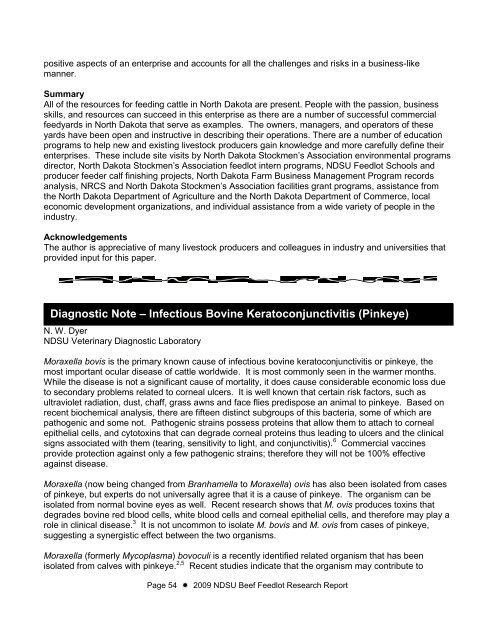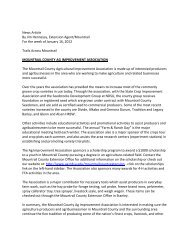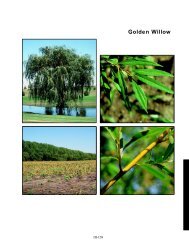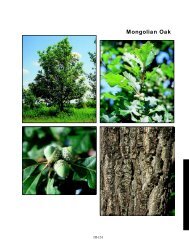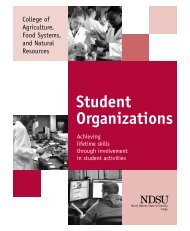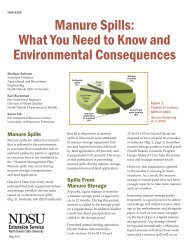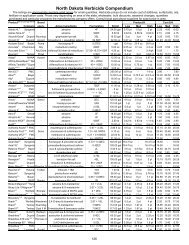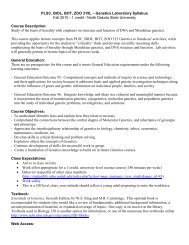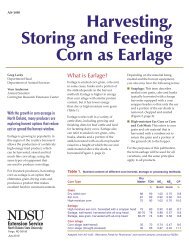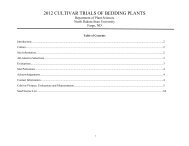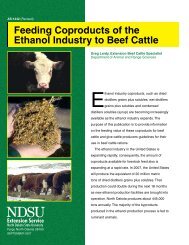NDSU Beef Feedlot - NDSU Agriculture - North Dakota State ...
NDSU Beef Feedlot - NDSU Agriculture - North Dakota State ...
NDSU Beef Feedlot - NDSU Agriculture - North Dakota State ...
Create successful ePaper yourself
Turn your PDF publications into a flip-book with our unique Google optimized e-Paper software.
positive aspects of an enterprise and accounts for all the challenges and risks in a business-like<br />
manner.<br />
Summary<br />
All of the resources for feeding cattle in <strong>North</strong> <strong>Dakota</strong> are present. People with the passion, business<br />
skills, and resources can succeed in this enterprise as there are a number of successful commercial<br />
feedyards in <strong>North</strong> <strong>Dakota</strong> that serve as examples. The owners, managers, and operators of these<br />
yards have been open and instructive in describing their operations. There are a number of education<br />
programs to help new and existing livestock producers gain knowledge and more carefully define their<br />
enterprises. These include site visits by <strong>North</strong> <strong>Dakota</strong> Stockmen’s Association environmental programs<br />
director, <strong>North</strong> <strong>Dakota</strong> Stockmen’s Association feedlot intern programs, <strong>NDSU</strong> <strong>Feedlot</strong> Schools and<br />
producer feeder calf finishing projects, <strong>North</strong> <strong>Dakota</strong> Farm Business Management Program records<br />
analysis, NRCS and <strong>North</strong> <strong>Dakota</strong> Stockmen’s Association facilities grant programs, assistance from<br />
the <strong>North</strong> <strong>Dakota</strong> Department of <strong>Agriculture</strong> and the <strong>North</strong> <strong>Dakota</strong> Department of Commerce, local<br />
economic development organizations, and individual assistance from a wide variety of people in the<br />
industry.<br />
Acknowledgements<br />
The author is appreciative of many livestock producers and colleagues in industry and universities that<br />
provided input for this paper.<br />
Diagnostic Note – Infectious Bovine Keratoconjunctivitis (Pinkeye)<br />
N. W. Dyer<br />
<strong>NDSU</strong> Veterinary Diagnostic Laboratory<br />
Moraxella bovis is the primary known cause of infectious bovine keratoconjunctivitis or pinkeye, the<br />
most important ocular disease of cattle worldwide. It is most commonly seen in the warmer months.<br />
While the disease is not a significant cause of mortality, it does cause considerable economic loss due<br />
to secondary problems related to corneal ulcers. It is well known that certain risk factors, such as<br />
ultraviolet radiation, dust, chaff, grass awns and face flies predispose an animal to pinkeye. Based on<br />
recent biochemical analysis, there are fifteen distinct subgroups of this bacteria, some of which are<br />
pathogenic and some not. Pathogenic strains possess proteins that allow them to attach to corneal<br />
epithelial cells, and cytotoxins that can degrade corneal proteins thus leading to ulcers and the clinical<br />
signs associated with them (tearing, sensitivity to light, and conjunctivitis). 6 Commercial vaccines<br />
provide protection against only a few pathogenic strains; therefore they will not be 100% effective<br />
against disease.<br />
Moraxella (now being changed from Branhamella to Moraxella) ovis has also been isolated from cases<br />
of pinkeye, but experts do not universally agree that it is a cause of pinkeye. The organism can be<br />
isolated from normal bovine eyes as well. Recent research shows that M. ovis produces toxins that<br />
degrades bovine red blood cells, white blood cells and corneal epithelial cells, and therefore may play a<br />
role in clinical disease. 3 It is not uncommon to isolate M. bovis and M. ovis from cases of pinkeye,<br />
suggesting a synergistic effect between the two organisms.<br />
Moraxella (formerly Mycoplasma) bovoculi is a recently identified related organism that has been<br />
isolated from calves with pinkeye. 2,5 Recent studies indicate that the organism may contribute to<br />
Page 54 2009 <strong>NDSU</strong> <strong>Beef</strong> <strong>Feedlot</strong> Research Report


